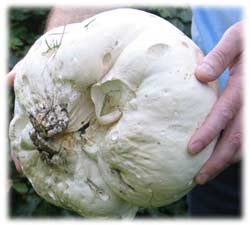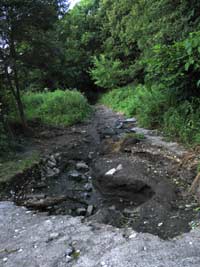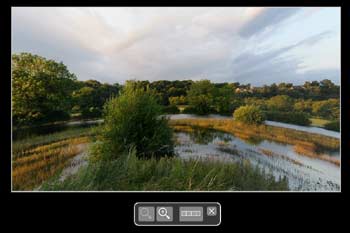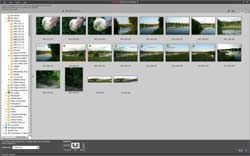 ‘CAN
YOU EAT IT?’asks Chris, our neighbour across the road.
He found
this giant puffball, the size and shape of a turban, on
the grassy paddock where they keep a pony. In several years, this is
the first he’s ever found there.
‘CAN
YOU EAT IT?’asks Chris, our neighbour across the road.
He found
this giant puffball, the size and shape of a turban, on
the grassy paddock where they keep a pony. In several years, this is
the first he’s ever found there.Giant Puffball |
Richard Bell's Wild West Yorkshire nature diary, Saturday, 7th July, 2007 |
 ‘CAN
YOU EAT IT?’asks Chris, our neighbour across the road.
He found
this giant puffball, the size and shape of a turban, on
the grassy paddock where they keep a pony. In several years, this is
the first he’s ever found there.
‘CAN
YOU EAT IT?’asks Chris, our neighbour across the road.
He found
this giant puffball, the size and shape of a turban, on
the grassy paddock where they keep a pony. In several years, this is
the first he’s ever found there.
 Barbara
and I tried giant puffball a few years ago and we decided we preferred to
use it for soup. Fried like mushroom it tasted fine - a bit mushroomy - but
we found
its spongy texture rather strange.
Barbara
and I tried giant puffball a few years ago and we decided we preferred to
use it for soup. Fried like mushroom it tasted fine - a bit mushroomy - but
we found
its spongy texture rather strange.
Chris tells us that the footpath at the lower end of Coxley Valley has been closed. At one end a fallen tree has blocked the path, at the other end the stream, overflowing a culvert, has made it's way over a small car park before flowing down the path, creating a series of 4 ft deep potholes on its way (right).
Some places had 4 inches of rain in 24 hours and it's been suggested that the deluge was a 'once in 400 year event', which, nonetheless, could happen again, since we seem to be getting more bouts of extreme weather. Locally, you can expect Coxley Beck to burst its banks about once every ten years but the recent flood was the worst anyone remembers, with the normally placid stream roaring like a mountain torrent.
'In places the stream was running where the path used to be,' says Chris, 'but in other parts of the valley the old stream bed has been abandoned and the stream has taken another route.'

We walk the long way around to see the damage, making the most of one of the few fine evenings we've had recently, and, on the way, take a look at the Strands which at the height of the flood became a lake, connecting the river with the canal. It now looks like a wetland reserve with mallards and tufted ducks swimming where in normal years a crop of hay would be growing.
 Panorama Maker
Panorama Maker I
took six overlapping images for the panorama above.
I
took six overlapping images for the panorama above.
Arcsoft offer a 15 day trial of their Panorama Maker which I found very easy to use. When I selected the first image in the sequence (left) it automatically picked out the adjoining 5, then it was just a matter of pressing the 'next' button to have it all stitched together.
If I'd continued to turn on the spot and taken another 6 images I could have stitched them together into a 360° panorama, which can be viewed in a Quick Time style window (right) to give a wrap-around, three-dimensional impression of a landscape.
Without investing in Quick Time Pro, I can't find a way of saving the virtual reality panorama so that you can see it here on a diary page. Any ideas please?

 My Canon
G5 digital camera has a facility for
making it easier to line up sections of a panorama as you take them, so, after
my
success with Strands,
I tried it out, sitting on the sofa in our living room. When you've taken your
first photograph (normally on the extreme left, though you could take a vertical
panorama too, of a waterfall or tower, for instance) a section of the first
shot appears to help you line up the next frame in the
sequence. This interior is made up of 9 separate photographs.
My Canon
G5 digital camera has a facility for
making it easier to line up sections of a panorama as you take them, so, after
my
success with Strands,
I tried it out, sitting on the sofa in our living room. When you've taken your
first photograph (normally on the extreme left, though you could take a vertical
panorama too, of a waterfall or tower, for instance) a section of the first
shot appears to help you line up the next frame in the
sequence. This interior is made up of 9 separate photographs.
Close-up architectural subjects are more difficult for the software (in this case PhotoStitch*, left) to match up convincingly - for instance, there's an obvious join on the radiator, centre right - but I can see that being able to take and stitch together panoramas so easily will be useful when I want to record a wildlife habitat.
West Yorkshire RIGS group, of which I'm secretary, has plans to survey 20 geological sites across the county so this will be an ideal way to show the rocky outcrops in the context of their surroundings.
*Reading the Canon G5 manuals, something I have never done in
depth before, I discovered that bundled with the camera's software there's
a simple program called PhotoStitch that
does exactly
what Panorama Maker does.